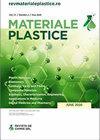Starch Modified Tough Biocompatible Polyurethane/acrylamide bio Composites: Physicochemical Properties and Biodegradation Studies
IF 0.6
4区 材料科学
Q4 MATERIALS SCIENCE, MULTIDISCIPLINARY
引用次数: 0
Abstract
Biodegradable bio composites with potential applications in medical implants were prepared with starch content by in situ polymerization technique using polyurethane prepolymers. (PU) and acrylamide (AAM) monomers. The structure and properties of bio composites were evaluated. FT-IR spectroscopy showed bonding between N=C=O functional group terminated polyurethanes confirmed improved compatibility of prepolymers, AAM, starch and bio composites. The DSC data are the glass transition (Tg) of the bio composite and ordinary polyacrylamide (PAAM) network. By incorporating starch and polyurethane in the form of an interpenetrating network into a polyacrylamide network, mechanical and thermal properties of bio composites due to higher crosslink density given by hard segment content. We studied the swelling behavior of both bio composites and individual PAAM networks under different pH conditions to validate their biocompatibility and potential use in biomedicine setting. The hydrolytic stability of biocomposites and PAAM networks was investigated using phosphate buffer. Hydrolytic stability of biocomposites was found to be higher comparison with PAAM network. Morphological analysis of the samples showed uniform distribution and good interfacial adhesion. Improves sample biodegradability it was revealed by the soil runoff test.淀粉改性韧性生物相容性聚氨酯/丙烯酰胺生物复合材料:理化性质及生物降解研究
以聚氨酯预聚物为原料,采用原位聚合技术以淀粉含量为原料,制备了具有潜在医用植入物应用前景的生物降解复合材料。(PU)和丙烯酰胺(AAM)单体。对生物复合材料的结构和性能进行了评价。FT-IR光谱显示,N=C=O官能团封端的聚氨酯之间的键合证实了预聚物、AAM、淀粉和生物复合材料的相容性得到改善。DSC数据是生物复合物和普通聚丙烯酰胺(PAAM)网络的玻璃化转变(Tg)。通过将淀粉和聚氨酯以互穿网络的形式结合到聚丙烯酰胺网络中,由于硬链段含量给出了更高的交联密度,生物复合材料的机械和热性能得到了改善。我们研究了生物复合材料和单个PAAM网络在不同pH条件下的溶胀行为,以验证其生物相容性和在生物医学环境中的潜在用途。用磷酸盐缓冲液研究了生物复合材料和PAAM网络的水解稳定性。与PAAM网络相比,生物复合材料的水解稳定性更高。样品的形态分析表明,样品分布均匀,界面附着力好。土壤径流试验表明,提高了样品的生物降解性。
本文章由计算机程序翻译,如有差异,请以英文原文为准。
求助全文
约1分钟内获得全文
求助全文
来源期刊

Materiale Plastice
MATERIALS SCIENCE, MULTIDISCIPLINARY-
CiteScore
1.40
自引率
25.00%
发文量
99
审稿时长
6-12 weeks
期刊介绍:
Materiale Plastice, abbreviated as Mater. Plast., publishes original scientific papers or guest reviews on topics of great interest.
The Journal does not publish memos, technical reports or non-original papers (that are a compiling of literature data) or papers that have been already published in other national or foreign Journal.
 求助内容:
求助内容: 应助结果提醒方式:
应助结果提醒方式:


